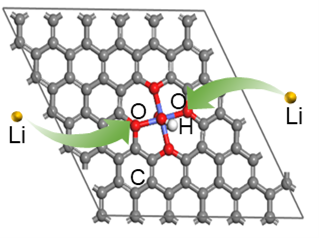H.D. Shi, Y.G. Li, P.F. Lu, Z.-S. Wu*
Acta Physico-Chimica Sinica, 2021, 37, 2008033.
DOI: 10.3866/PKU.WHXB202008033 [PDF]

Lithium (Li)-based batteries are the dominant energy source for consumer electronics, grid storage, and electrified transportation. However, the development of batteries based on graphite anodesis hindered by their limited energy density. With its ultrahigh theoretical capacity (3860 mAh∙g−1), low redox potential (−3.04 V),and satisfactorily low density (0.54 g∙cm−3), Li metal is the most promising anode for next-generation high-energy-density batteries. Unfortunately, the limited cycling life and safety issues raised by dendrite growth, unstable solid electrolyte interphase, and “dead Li” have inhibited their practical use. An effective strategy is to developa suitablelithiophilic matrix for regulating initial Li nucleation behavior and controlling subsequent Li growth. Herein, single-atom cobalt coordinated to oxygen sites on graphene (Co-O-G SA) is demonstrated as a Li plating substrate to efficiently regulate Li metal nucleation and growth. Owing to its dense and more uniform lithiophilic sites than single-atom cobalt coordinated to nitrogen sites on graphene (Co-N-G SA), high electronic conductivity, and high specific surface area (519 m2∙g−1), Co-O-G SA could significantly reduce the local current density and promote the reversibility of Li plating and stripping. As a result, the Co-O-G SA based Li anodes exhibited a high Coulombic efficiency of 99.9% ata current density of 1 mA∙cm−2with a capacity of 1 mAh∙cm−2, and excellent rate capability (high current density of 8 mA∙cm−2). Even ata high plating capacity of 6 mAh∙cm−2,the Co-O-G SA electrode could stably cycle for anultralong lifespan of 1300 h. In the symmetric battery, the Co-O-G SA based Li anode (Co-O-G SA/Li) possessedastable voltage profile of 18 mV for 780 h at 1 mA∙cm−2, and even ata high current density of 3 mA∙cm−2, its overpotential maintaineda small hysteresis ofapproximately 24 mV for > 550 h.Density functional theory calculations showed that the surface of Co-O-G SA had a stronger interaction with Li atoms with a larger binding energy,−3.1 eV, than that of Co-N-G SA (−2.5 eV), leading toa uniform distribution of metallic Li on the Co-O-G SA surface.More importantly, when matched witha sulfur cathode, theresulting Co-O-G SA/lithium sulfur full batteries exhibiteda high capacity of1002 mAh∙g−1, improved kinetics witha small polarization of 191 mV, and anultralow capacity decay rate of 0.036% per cycle for 1000 cycles at 0.5C(1C= 1675 mA∙g−1)witha steadyCoulombic efficiency of nearly 100%. Therefore,this work provides novel insights into thecoordination environment of single atoms for the chemistry of Li metal anodes for high-energy-density batteries.